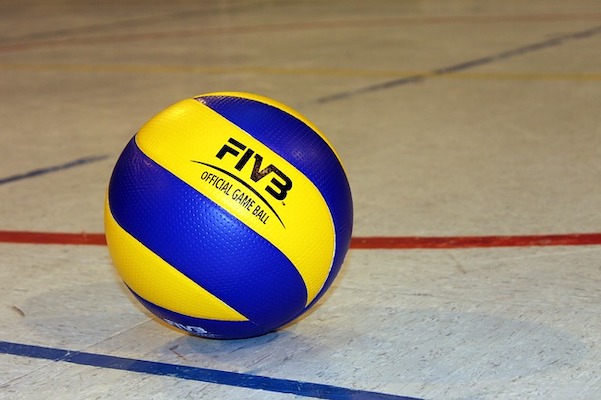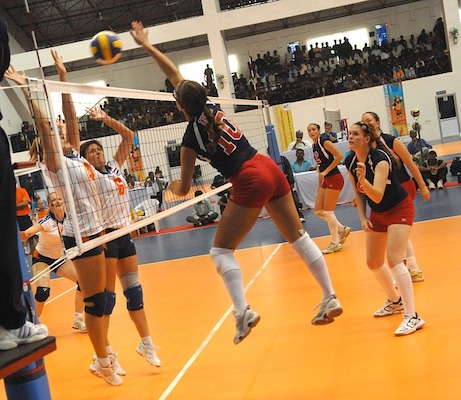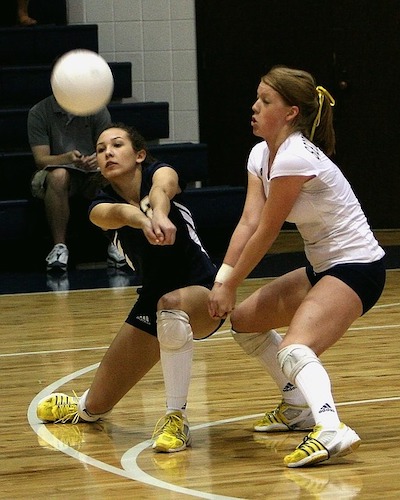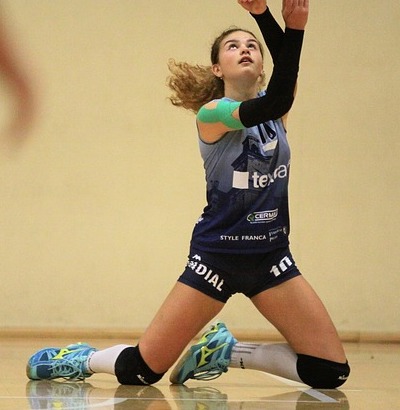

How to Buy Volleyball Shoes
Are volleyball shoes actually a thing?
If you’re anywhere near my age, you remember playing volleyball in school wearing the same pair of sneakers that you wore for every other physical activity – running, basketball, gym class, playing outside, family vacations, etc.

But these days, athletic shoes are specialized for different sports for optimal performance and foot protection. If you’re serious about any sport in particular, you better have the right shoes. And volleyball is no different.
So if you now have a daughter who is playing the sport, or if you’ve found a recreational volleyball league for yourself, here are some tips for finding the right shoes to keep you comfortable and decrease your chance of injury.
What Makes Volleyball Shoes Different
(It’s More Than You Think)
Volleyball shoes may look like basketball or tennis shoes, but they are actually quite different. The most important difference is the sole, which is made of gum rubber. This kind of rubber is stickier and offers more traction for the quick cuts and starting and stopping movements volleyball players make.
Indoor games are played on smooth, wooden or Taraflex courts, which can quickly get dusty and become slippery. The gum material grips better than other types of rubber in shoes designed for use on concrete or trails. The intricate, flexible tread patterns of gum rubber also aid in traction, and the material is non-marking to protect gym floors.
 Volleyball shoes are designed for traction on indoor courts
Volleyball shoes are designed for traction on indoor courtsSeveral other features are unique to volleyball shoes, and they address specific needs to provide a better wearer experience. Since players spend most of their time during matches on the balls of their feet jumping and landing, the majority of the cushioning and shock-absorption materials in the shoe are found in the midsole to protect this part of the foot.
The cushioning is important to protect your knees, ankles, ligaments, and lower back from all the pounding involved in the sport. It also provides comfort when you’re on your feet for several hours of matches.
Another feature that protects your ankles is the rounded edges of the sole along the sides, heels, and toes. Sharp soles are more appropriate on running shoes because runners generally move in straight lines. But the rounded base of volleyball shoes helps you quickly shift your weight and change direction, making them a little more forgiving and less likely to lead to ankle rolling.
 Volleyball players spend a lot of time jumping and standing on their toes
Volleyball players spend a lot of time jumping and standing on their toesMost volleyball shoes have extra ankle support to keep feet stable during landings and all the lateral movements required by the sport. Some even come in hi-cut styles for additional protection.
Going hand in hand with support is durability. Volleyball shoes need to be durable to withstand the intense jumping and movement involved in the game. They should be reinforced in the right places to keep them from wearing out. This includes the ankle and lateral support as well as reinforced areas around the toes. Players spend a lot of time on their toes, so volleyball shoes should include rubber toe guards and toe caps.
Serious players should expect their volleyball shoes to last at least one full season. Casual players can probably use the same shoes for quite a bit longer than that. The traction is usually the first thing to go with these shoes, followed by support and cushioning.
 Volleyball requires a lot of lateral movement
Volleyball requires a lot of lateral movementVolleyball shoes need to be lightweight so players can jump and move quickly without feeling a heavy shoe weighing them down. The weight of the shoe can vary, depending on the materials used. Mesh and synthetic materials are usually lighter and more breathable, which is good for keeping your feet cool too. Shoes may also be made of leather, which tends to be heavier but more durable.
Whatever materials you choose, the shoes should be flexible to allow you to get up onto your toes. They should bend naturally where your feet bend and have a low profile for speed and comfort.
Volleyball Shoe Brands
Several athletic shoe brands make volleyball shoes for women. They include Adidas, Asics, Mizuno, Nfinity, Nike, and Under Armour. Of these, the most common and leading sellers are Asics and Mizuno.
Asics volleyball shoes are usually made with more mesh for better breathability, and Mizuno shoes have more leather, which makes them a little more durable. Although no volleyball shoe brands offer wide styles, Asics tend to be wider than Mizuno, especially in the toe box.
 A player wearing Mizuno volleyball shoes
A player wearing Mizuno volleyball shoesSome volleyball shoes are more expensive than others. The price is usually due to shoe technology that is designed specifically for the needs of volleyball players, as well as production costs. The amount of technology, time, research, and development that goes into the shoes affects the production costs and is reflected in their price.
When you shop for volleyball shoes, be sure to wear the socks that you’ll be wearing during play to assure a proper fit. Also try out a couple of volleyball moves, such as jumping and changing directions, to check for flexibility and comfort.
Summing It Up
Now that I’ve given you details about what to look for when buying volleyball shoes, here’s a quick checklist to sum it all up:
- Gum rubber sole
- Midsole cushioning
- Rounded sole edges
- Ankle and lateral support
- Reinforced toes
- Breathable, lightweight, yet durable materials
- Natural flexibility
Once you’ve chosen your proper footwear, it’s up to you to bump, set, and spike your way to victory.
 Players wearing a variety of volleyball shoe brands
Players wearing a variety of volleyball shoe brandsRelated: A Rundown of Running Shoes
